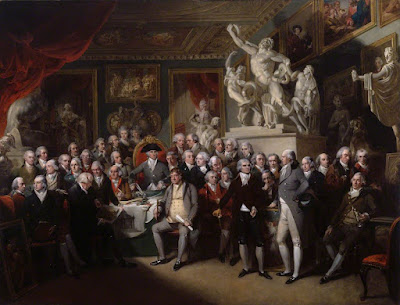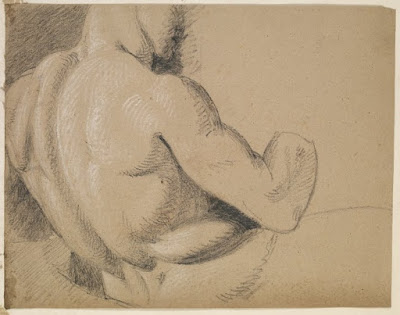 |
| Johan Zoffany Charles Towneley in his Sculpture Gallery 1782 oil on canvas Art Gallery and Museum, Burnley |
 |
| Edward Francis Burney The Antique School of the Royal Academy at Old Somerset House 1779 drawing, with watercolor Royal Academy of Arts, London |
 |
| Edward Francis Burney The Antique School of the Royal Academy at New Somerset House 1780 drawing, with watercolor Royal Academy of Arts, London |
 |
| Anonymous British Artist The Antique School of the Royal Academy at New Somerset House ca. 1780-83 oil on canvas Royal Academy of Arts, London |
"Casts from the antique are illuminated by oil lamps with large triple reflectors set up on high standards. Each student's easel is illuminated by its own oil lamp and reflector. A lamp and reflector are also situated in front of the desk of the Keeper [against the right-hand wall], strongly delineating his features. Casts include, from left to right, the Dancing Faun, the Wrestlers, Belvedere Torso, Cincinnatus, Apollo Belvedere, Borghese Gladiator, and Meleager. A screen has been inserted along the wall behind the Belvedere Torso to sharpen the contours. This practice appears to have been imported from Italy and was recommended to artists by English writers on art from the mid 17th century."
Drawing casts by lamplight was often deemed preferable to drawing by daylight – the sharper shadows better emphasizing and defining anatomical details.
"This painting was exhibited at the British Institution in 1819. It shows the room in which the Elgin Marbles, including the most important pedimental sculptures and metopes from the Parthenon, were exhibited to the public between 1817 and 1831. The bas-reliefs and statuary were removed from the Acropolis and shipped to England between 1801 and 1811, and formed part of the collection of antiquities assembled by Thomas Bruce, 7th Earl of Elgin, during his diplomatic mission to Constantinople between 1801 and 1803. They had been accommodated first at the house of the Duchess of Portland in Westminster, and subsequently in a shed in Park Lane, where in June 1808 a well-known boxer named Gregson was 'placed in many attitudes' in order to compare them with figures in the Marbles. In 1811 Elgin offered the Marbles to the nation for £62,440. After a prolonged Parliamentary inquiry, they were purchased from him in 1816 for £35,000, and handed over to the British Museum. The painter of this work, Archibald Archer, is shown seated in the right foreground. The President of the Royal Academy, Benjamin West, is seated at the left, while to his right is Joseph Planta, Principal Librarian at the British Museum. Benjamin Robert Haydon, the most fervent advocate of the Marbles, is standing, in profile, at the extreme left."
The drawing directly above is misidentified by the British Museum as representing one of Haydon's many large drawings of the Elgin Marbles – when in fact it was rendered after a cast of the Belvedere Torso. The original antique sculptural fragment – documented in Rome since the 1430s – had acquired cult status in the early 16th century due to the reputed admiration of Michelangelo. Consequently, by the 18th century, every art academy in Europe was displaying its own plaster copy of the Belvedere Torso for the edification of students.
"Angelica Kauffmann, as a woman, could not work from the living model at the Royal Academy, even though she was a founder member. J.T. Smith, who had heard that Kauffmann had arranged private sessions with a Royal Academy model named Charles Cranmer, went round to see him to find out if this was true. Cranmer told Smith that 'he did frequently sit before Angelica Kauffmann at her home on the south side of Golden Square, but that he had only exposed his arms, shoulders, and legs, and that her father, who was also as artist and likewise an exhibitor at the Academy, was always present."
 |
| Henry Singleton Royal Academicians in General Assembly 1795 oil on canvas Royal Academy of Arts, London |
 |
| Archibald Archer The Temporary Elgin Room at the British Museum 1819 oil on canvas British Museum |
"This painting was exhibited at the British Institution in 1819. It shows the room in which the Elgin Marbles, including the most important pedimental sculptures and metopes from the Parthenon, were exhibited to the public between 1817 and 1831. The bas-reliefs and statuary were removed from the Acropolis and shipped to England between 1801 and 1811, and formed part of the collection of antiquities assembled by Thomas Bruce, 7th Earl of Elgin, during his diplomatic mission to Constantinople between 1801 and 1803. They had been accommodated first at the house of the Duchess of Portland in Westminster, and subsequently in a shed in Park Lane, where in June 1808 a well-known boxer named Gregson was 'placed in many attitudes' in order to compare them with figures in the Marbles. In 1811 Elgin offered the Marbles to the nation for £62,440. After a prolonged Parliamentary inquiry, they were purchased from him in 1816 for £35,000, and handed over to the British Museum. The painter of this work, Archibald Archer, is shown seated in the right foreground. The President of the Royal Academy, Benjamin West, is seated at the left, while to his right is Joseph Planta, Principal Librarian at the British Museum. Benjamin Robert Haydon, the most fervent advocate of the Marbles, is standing, in profile, at the extreme left."
 |
| Benjamin Robert Haydon Ilissos (or Theseus) from the East Pediment of the Parthenon (Elgin Marbles) 1808 drawing British Museum |
 |
| Benjamin Robert Haydon Ilissos (or Theseus) from the East Pediment of the Parthenon (Elgin Marbles) 1808 drawing British Museum |
 |
| Benjamin Robert Haydon Metope with Lapith from the Parthenon (Elgin Marbles) 1809 drawing British Museum |
 |
| Benjamin Robert Haydon Horse of Selene from the East Pediment of the Parthenon (Elgin Marbles) 1809 drawing British Museum |
 |
| John Landseer Heads of Horses from the Parthenon Pediments (Elgin Marbles) 1817 etching Wellcome Collection, London |
 |
| Benjamin Robert Haydon Study of a Cast of the Belvedere Torso ca. 1808-1811 drawing British Museum |
The drawing directly above is misidentified by the British Museum as representing one of Haydon's many large drawings of the Elgin Marbles – when in fact it was rendered after a cast of the Belvedere Torso. The original antique sculptural fragment – documented in Rome since the 1430s – had acquired cult status in the early 16th century due to the reputed admiration of Michelangelo. Consequently, by the 18th century, every art academy in Europe was displaying its own plaster copy of the Belvedere Torso for the edification of students.
 |
| Joseph Highmore Studies of a Cast of the Belvedere Torso ca. 1712-15 drawing Tate Britain |
 |
| John James Masquerier Studies of a Cast of the Belvedere Torso ca. 1790-93 drawing Wellcome Collection, London |
 |
| Joseph Mallord William Turner Study of a Cast of the Belvedere Torso ca. 1795 drawing Victoria & Albert Museum, London |
 |
| Angelica Kauffmann Allegory of Design (Artist studying the Belvedere Torso) ca. 1778-80 oil on canvas Royal Academy of Arts, London |
"Angelica Kauffmann, as a woman, could not work from the living model at the Royal Academy, even though she was a founder member. J.T. Smith, who had heard that Kauffmann had arranged private sessions with a Royal Academy model named Charles Cranmer, went round to see him to find out if this was true. Cranmer told Smith that 'he did frequently sit before Angelica Kauffmann at her home on the south side of Golden Square, but that he had only exposed his arms, shoulders, and legs, and that her father, who was also as artist and likewise an exhibitor at the Academy, was always present."
– quoted passages from The Artist's Model: its Role in British Art from Lely to Etty by Ilaria Bignamini and Martin Postle (exhibition catalogue, Nottingham University Art Gallery, 1991)
 |
| Anonymous British Artist Antique School at the Royal Academy ca. 1790 drawing, with watercolor British Museum |